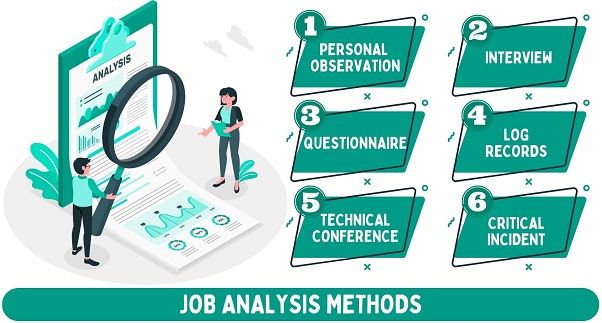Job Analysis Methods are the means of acquiring essential job-related information like – Duties, Skills-set and Responsibilities. It is a vital step in the Job Analysis Process.
Selecting suitable candidates for Jobs is crucial for all organizations. For this purpose, the organization appoints dedicated personnel called Job Analysts.

The job analyst needs some data based on which he can understand various roles and their requirements. And, they acquire this data with the help of several methods available for job analysis.
Further, they use this data to design Job Descriptions and Specification post analysis.
Also read: Job Description vs Job Specification
Some commonly used methods are as follows:
- Observation
- Interview
- Questionnaire
- Diary Method
All the methods focus on gathering in-depth and authentic job-related information. The data retrieved by these methods are valuable and confidential.
The analyst can use a single method or a combination thereof that serves the purpose of analysis. Besides, its pros and cons must be critically analyzed before implementing any method.
The implementation of analysis is the combined effort of important players, namely:
- Job Analyst or HR Specialist
- Worker or Job Holder
- A supervisor or Immediate Senior
In addition, the analyst must remember the purpose behind Data Collection. Also, they must present their observations to the supervisor and workers for review.
Content: Job Analysis Methods
Basics of Job Analysis
Before jumping straight to the methods, let’s understand the basics.
What is a Job?
It is the division of total work in the organization into various positions. These positions are entitled to some Duties, Responsibilities and require specific Knowledge and Skills. Moreover, it is to be occupied by a suitable candidate called Job Holder.
What is Job Analysis?
It is a systemized process of collecting vital information regarding the Job. Moreover, it determines the required skills and capabilities and hires the best fit for a Job.
It is alternatively known as the Anatomy of Jobs.
Who is a Job Analyst?
A job analyst is the one who conducts the job analysis in the organization. They are crucial to the process as a whole. This is because, the job’s effectiveness and efficiency heavily depend on the effective job design.
Usually, firms appoint a Supervisor or HR Specialist as the Job Analyst. They must keenly observe the Job and design a strong description and specifications.
What is the need for Job Analysis?
The points below explain the need and uses of conducting a job analysis:
- Identification of potential jobs.
- Investigating the purpose of a job.
- Finding the exact fit for the specific Job.
- Duties and Responsibilities of the Worker.
- Remuneration and Selection of the job holder.
- Material and equipment requirements.
- Optimization is a worker’s performance.
- Reporting relationships in the organizational structure.
Methods of Job Analysis
Job analysis methods distinguish from one another in terms of scope and usage. Majorly, it depends on observations and study, which helps in extracting valuable data.
The Internal and External HR specialists appointed for analysis can implement these methods.
The following are some standard methods with their possible pros and cons.
1. Personal Observation
It is a simple and easy method the job analyst uses for data collection.

Here, the analyst observes the job holder while at work. By doing so, they get first-hand and authentic information directly from the source. Also, they can make a note of the complete process and activities undertaken thereof.
However, each analyst may possess a different perspective towards things. Therefore, the interpretations may vary from person to person. This is where the complications peep in, making it a simple yet complex task.
Important Points
- It will be a helpful activity if the objective of observation is clear.
- It is advantageous only for those jobs which involve some kind of movement.
- Only adequate for tasks that take less time.
- The Job must have scope to retrieve some useful information out of it.
Pros
- Gives answers to questions like:
- What is being done?
- How it is being done?
- How much time is required?
- It helps in quantifying the data.
- It serves as a base for deciding compensation.
Cons
- Very time-consuming method.
- Only suitable for some kinds of jobs.
- Demands trained and expert analyst.
- It only works well when used in combination.
Example: Every employee’s performance gets monitored throughout the year. Further, this data is helpful for comparison purposes during recruitment.
2. Interview
In this method, the job analyst interviews the job holder and his supervisor. Based on the interview, they determine the patterns and challenges faced during the Job.

It involves open-ended discussion in an interview setup or over a call. Also, analysts use a structured form to support the process. After that, the interviewer or the analyst passes judgement and records his analysis.
The data collected is the job holder’s personal job analysis. The effectiveness of the process greatly depends upon the analyst’s skills and the job holders’ interests.
Pros
- Receives direct information.
- Employee’s personal job analysis.
- Detailed information about the Job and environment.
Cons
- Time-consuming method.
- A biased analyst can interpret misleading results.
Example: Exit Interviews are the most common example of this method. In exit interviews, the analysts ask for details about Job’s positive and negative aspects. Later, this data helps in redesigning the Job.
3. Questionnaire
A questionnaire is a set of generic or specific questions to retrieve job information. It mainly consists of multiple-choice questions.

The structure of the questionnaire depends on the type of information to be collected. It is to be filled by the workers themselves.
This job analysis method is suitable for collecting data from many workers simultaneously. But, the nature of Job must be the same. Moreover, the analysts must take extreme caution while crafting the questions.
It must cover areas like:
- Job title of the job holder and supervisor.
- Reporting relationships of the job holder.
- A detailed description of the Job.
- Details about Tasks and Duties.
- Resolution of Issues (if any).
Pros
- Involvement of less staff for data collection.
- Saves lots of time for the Job holder and the analyst.
Cone
- Employees may not express themselves clearly.
- Some workers may fill wrong information.
- Wrong or complex questions can make it a wasteful activity.
Example: In factories, the workers are asked to give feedback using questionnaires.
4. Log Records
This method requires job holders to observe themselves. They need to record their daily activities in a Log Book or Diary. For this reason, it is additionally known as the Dairy Method.

Thus, it captures all the tasks, duties and the employee’s capacity at work.
The dairy method is the instant source of information gathered by the holder himself. It has weightage over other methods as it rules out memory loss errors.
However, it takes the job holder a significant amount of time to jot down their activities.
Pros
- Get the complete day-to-day data.
- Covers even the minute details.
- Eliminates the error of memory lapse.
Cons
- Employees may fill incorrect data.
- The analyst takes time to process a massive bunch of records.
- Suitable only for small-sized organizations.
Example: The companies are often asked to fill their log books before leaving. Later, the HR specialist analyses the accumulated day-to-day data and makes interpretations.
5. Technical Conference
Here, the HR specialist organizes a conference and invites experts from the respective field. These experts are highly skilled people having years of experience and knowledge.

The analyst begins the conference and lets the expert take over. Furthermore, they share their expertise and views about the fields, opportunities and trends.
However, it is more on the knowledgeable front and doesn’t consider the employee’s view.
Pros
- Holistic and expert view about the Job.
- Introduction of new trends and practices.
Cones
- Doesn’t take ground-level data.
- Sometimes it accumulates inaccurate data.
Example: Almost all companies currently organize programmes like Webinars, Conferences and Submits. It can be generalized or specific, like HR Submit, Doctors Submit, etc.
6. Critical Incident
It is also a form of an interview which investigates the actual incidences of employees’ on-the-job behaviour. In other words, it analyses the employee’s behaviour and expertise while handling or resolving a critical incident.

Besides, it involves a set of procedures for collecting information from the employee. Analysts also develop a questionnaire so that the employee doesn’t miss anything.
Pros
- The new employees get to learn from such incidents.
- Analysts can identify the loopholes and resolve them.
Cons
- The incidences differ, so it may not work in the same way again.
Example: Dealing with a serious complaint from a customer. One can note or record the course taken to handle the situation. An interview can also be scheduled to ensure that everything is on the records precisely.
Which one to follow?
It depends upon the purpose to be served by the collected job analysis data.
None of the methods mentioned above are universally applicable. Every method has its share of merits and demerits. However, one can obtain the best results by combining one or more methods.
However, some important practical issues must be considered before selecting any method:
- Past record of the shortlisted method and its effectiveness.
- Availability of the resources like several questionnaires available, be it generic or specific.
- The number and size of the respondents are to be analyzed.
- The cost incurred in implementing the shortlisted method of job analysis.
- Time required to complete the overall process.
Final Words
To sum up, the analyst must be cautious when selecting the method for job analysis. The efficiency and effectiveness of a Job affect the organization’s overall performance.
Moreover, the process must comply with the companies’ goals, demands, and requirements.
Leave a Reply